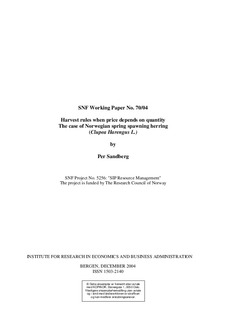| dc.description.abstract | For fish stocks where the unit price of harvest is constant, unit harvest costs independent of quantity and non-increasing in biomass, regulation based on target escapement has been shown to optimise the net present value of harvest to society. Such a policy will result in a bang-bang regulation with closure of the fishery once the fish stock drops below the target and vice versa. The optimality of the target escapement policy has, under the same economic conditions, also been shown to hold for fish stocks characterised by stochastic recruitment. In this paper, the optimality of a target escapement policy for a fish stock with stochastic recruitment, but unit price of harvest decreasing in quantity, is empirically investigated, in the case of the Norwegian fishery on Norwegian spring spawning herring. For this fishery, it is found that a target escapement policy is no longer optimal. | en |
